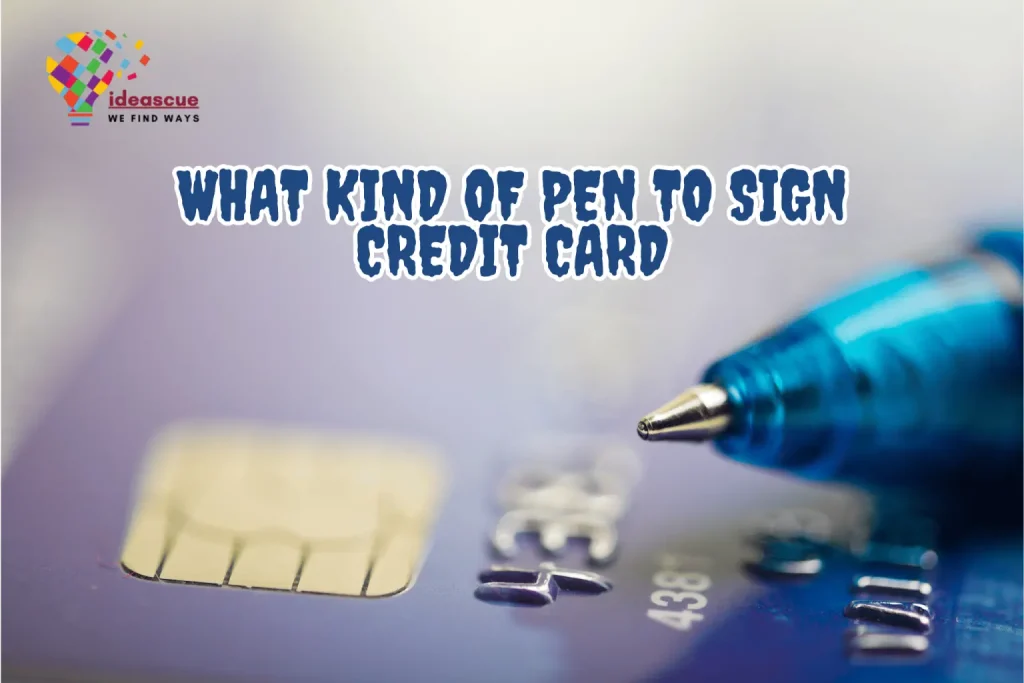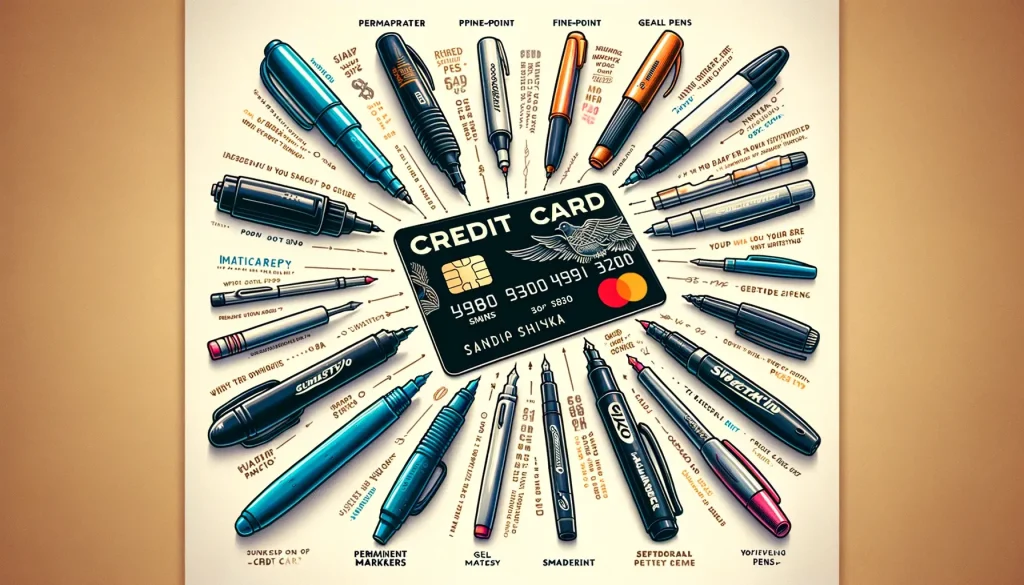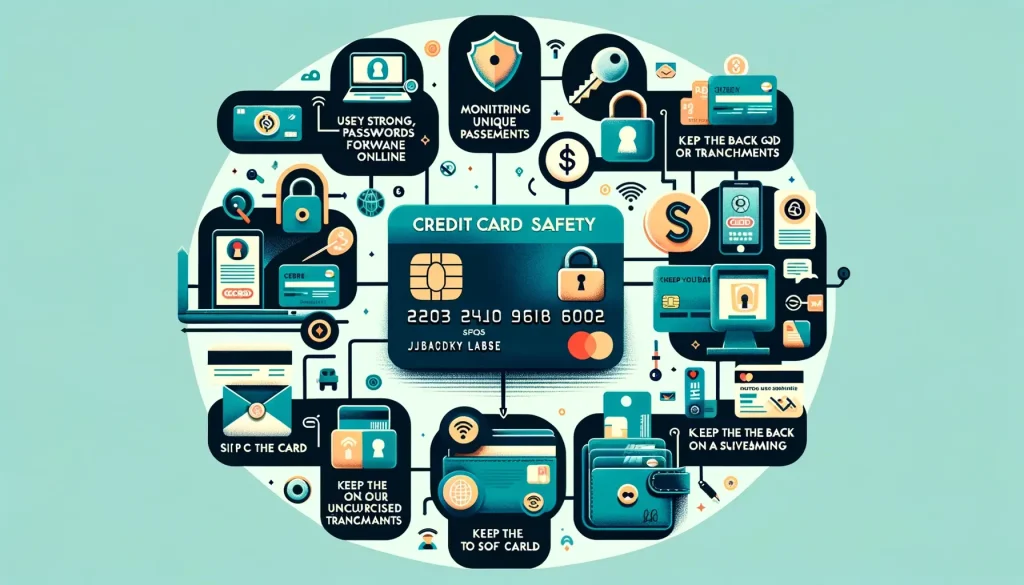What Kind of Pen to Sign Credit Card?
Introduction:
Have you ever paused and wondered what kind of pen to sign credit card with? This is a topic that is often not considered in our regular thoughts, yet it’s quite essential. Selecting an appropriate pen is crucial to guarantee that your signature remains permanent and unique.
In the world of credit cards, not all pens are created equal.
That’s right, the pen you use to jot down a grocery list might not be the best pick for signing the back of your card. Let’s dive into why the choice of pen matters and which ones are the best fit for this task.

Signing your credit card is one of the first steps to secure your financial identity. Though you can sign with any pen given, here are some recommended pens to keep your identity unique but at the same time give an aesthetic look. Below are some ordinary yet attractive pens people use to sign their credit cards.
How to Sign a Credit Card?
Look for Signature Strip:
The strip where you sign is usually found on the reverse side of the card. Make sure the area is clean and free from grease or dirt.
Sign the Strip:
Use your chosen pen to sign within the designated area. Ensure your signature is consistent with the one on your ID documents.
Ink Will Start Drying:
To avoid smudging, spare the ink a moment to dry. This is especially important for gel pens or other inks that take longer to set.
Types of Pens That are Best to Sign the Back of a Credit Card:
Permanent Markers:
Permanent markers are excellent for credit card signatures due to their robust, fade-resistant ink. Their advantage lies in the permanence of the ink, This material is designed to withstand water exposure, prevent smudging, and resist fading over time. This feature ensures that your signature will remain visible throughout the lifespan of your credit card.
However, it’s crucial to choose a permanent marker with a fine tip to avoid the ink bleeding beyond the signature strip. Additionally, the quick-drying nature of permanent marker ink means less chance of smudging right after signing.
Fine-tip Ballpoint Pen:
Fine-tip ballpoint pens offer precision and reliability. The ink in these pens is oil-based, which means it dries quickly and is less likely to smudge or smear. The fine tip is especially useful for credit cards, as it ensures your signature is neat and confined to the small space of the signature strip.
Ballpoint pens are also known for their durability and long-lasting ink, making them a practical and economical choice for signing credit cards. Their common presence and simple operation make them a favored choice for numerous people.
Metal-tipped Pen:
Metal-tipped pens, often found in high-end writing instruments, offer a superior writing experience. These pens are typically equipped with fine, durable tips that provide an excellent level of control and precision.
The ink flow in metal-tipped pens is usually consistent and smooth, making your signature look professional and elegant.
While they might be more expensive, metal-tipped pens are a worthwhile investment for those who value quality and aesthetics in their writing tools. They are particularly suitable for individuals who sign multiple cards or documents regularly and seek a dependable, stylish pen.
Gel Pen:
Gel pens are a popular choice for those who prefer a smooth, vibrant signature. The gel-based ink flows smoothly and provides a distinct color saturation that makes your signature stand out. These pens are available in various colors but stick to standard blue or black for credit card signatures.
The downside of gel pens is that they take longer to dry, so you should wait a few seconds after signing to ensure the ink sets properly. Gel pens combine aesthetic appeal with practicality, making them a stylish yet practical choice.
Color and Quality of The Ink:
The color of the ink is essential, too. Black or blue ink is preferred as it is more visible and universally accepted. The ink quality should be such that it doesn’t fade quickly, ensuring your signature remains visible for as long as you have the card. While blue is acceptable, black is considered more professional.
Why Choosing the Right Pen Matters:
Choosing the right pen for signing your credit card is more than a matter of preference; it’s a security measure. A clear, indelible signature can deter fraud and prove your identity if your card is stolen. Moreover, a properly signed card is often required by merchants for transactions.
What Color Ink Should You Use to Sign a Credit Card?
Traditionally, black or blue ink is recommended for signing credit cards. These colors provide high visibility and contrast, making your signature easy to read and photocopy if needed for verification purposes.

What to Look for When Buying a Credit Card Pen?
Tip Size and Style:
The size of the tip influences how accurately you can sign. A fine or ultra-fine tip is recommended for a clear and detailed signature that doesn’t exceed the limited space on the card.
Grip and Design:
A pen with a comfortable grip can make a big difference, especially if you’re signing multiple cards. Ergonomic designs are made to lessen hand tiredness and enhance how well you can control things.
Ink Type:
The ink should be waterproof, fade-resistant, and quick-drying. This prevents your signature from smudging or becoming illegible over time.
How to Sign a Credit Card?
Here are some steps to sign your credit card like a pro:
Writing ‘See ID’ On the Back of Your Credit Card:
Have you ever thought about writing ‘See ID’ instead of your signature on the back of your credit card? It’s a trick some people use as an extra layer of security. When you write ‘See ID,’ you ask merchants to check your identification whenever the card is used.
This can be a smart move to prevent unauthorized use. If someone swipes your card, the idea is that the cashier will ask for your ID, spot the mismatch, and stop the transaction.
Why Some Pens Aren’t Suited for Signing Credit Cards:
Not all pens are appropriate for signing credit cards. For instance, standard ink pens might smudge or fade, while highlighters and pencils can be easily erased or altered.
Can I Leave the Signature Line Blank?
Well, it’s tempting to leave that little strip blank, but here’s the thing – it’s not the best move. Signing your credit card is a big deal for your security. When you sign, it’s like putting a little personal seal of approval on your card. If a thief gets their hands on it, the signature makes it more challenging for them just to start shopping with your card.
Why Should You Sign Your Credit Card?
Signing your credit card is like adding a personal seal of approval. It’s a little act that ensures a big weight in protecting your finances. Think of your signature as a guard, standing firm against anyone who tries to misuse your card. Plus, it’s a quick check for cashiers to match your card with your ID, keeping your transactions safe and sound.
Credit Card Safety:
Besides signing your card, remember to monitor your statements for any unauthorized transactions regularly. Keep your credit card secret to yourself, and never disclose your PIN or card details to anyone.

FAQs
Conclusion:
So, when it comes to what kind of pen to sign credit card, it’s clear that the right pen can make a big difference. Permanent markers, gel pens, fine-tip ballpoint pens, and metal-tipped pens have unique advantages.
Choosing the right pen is a small but mighty step in protecting your financial identity. A well-signed card deters fraudsters and proves it’s yours. So next time you’re about to sign that card, pause and pick a pen that does the job right. It’s a simple move but one that carries a lot of weight in keeping your finances secure.




